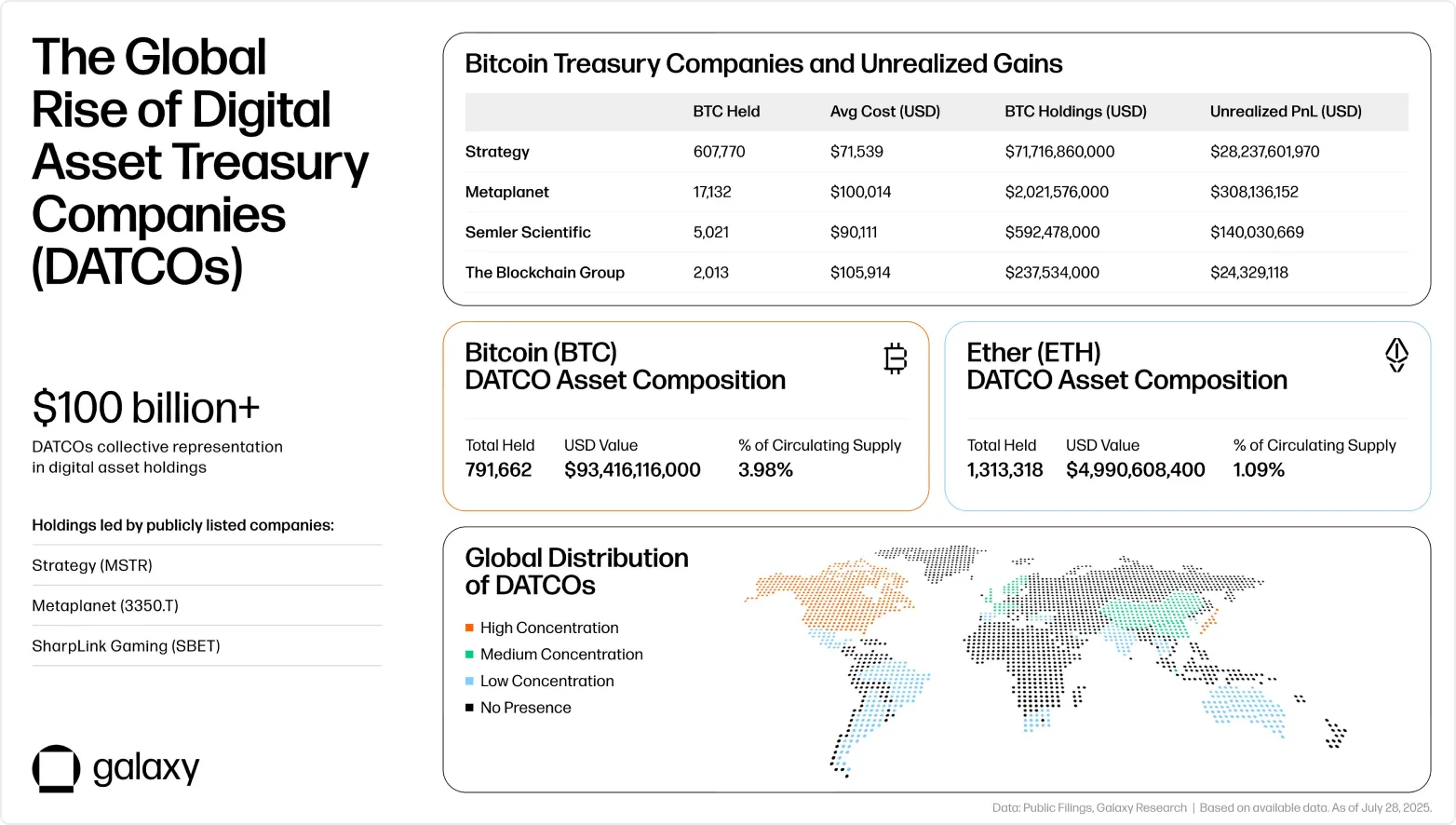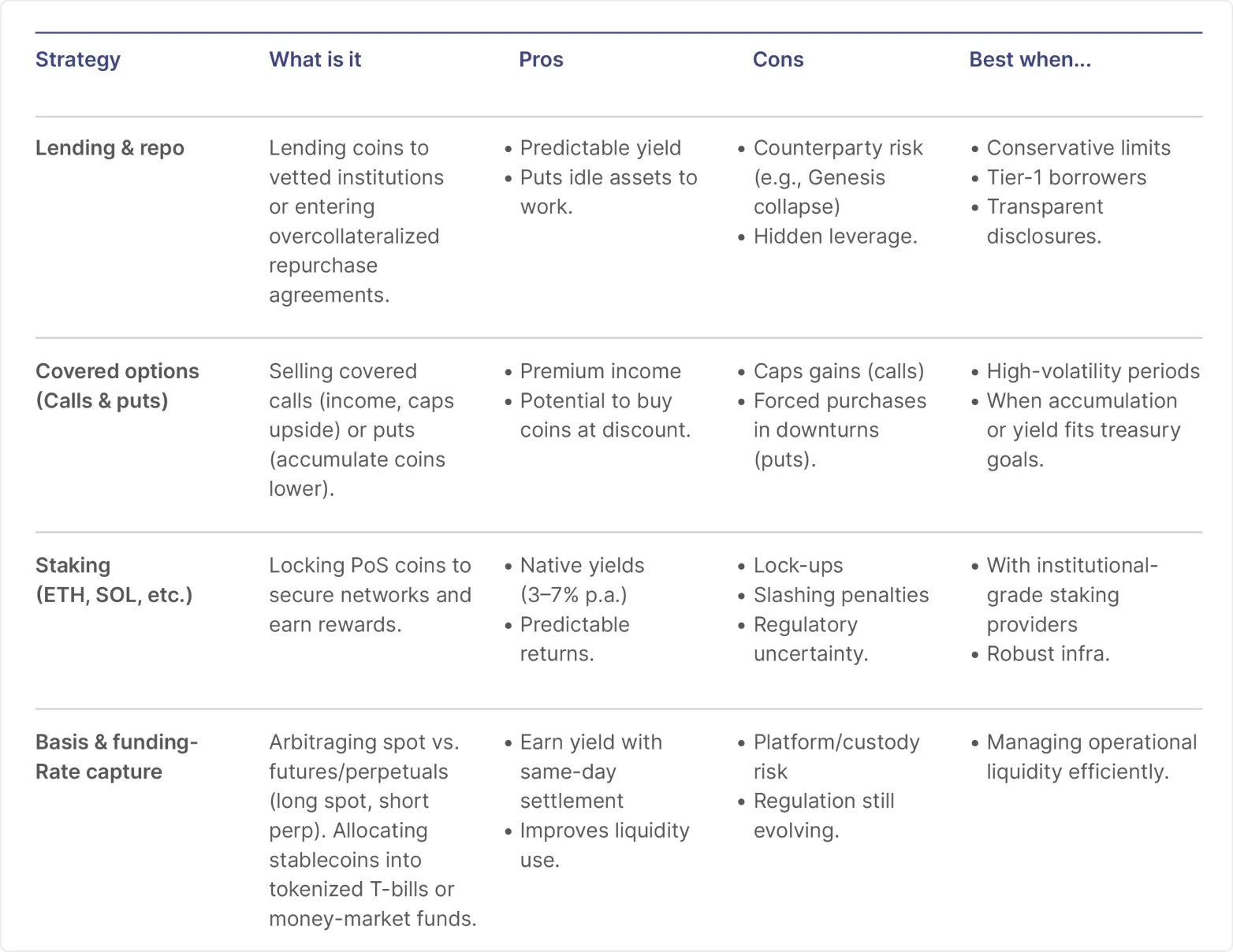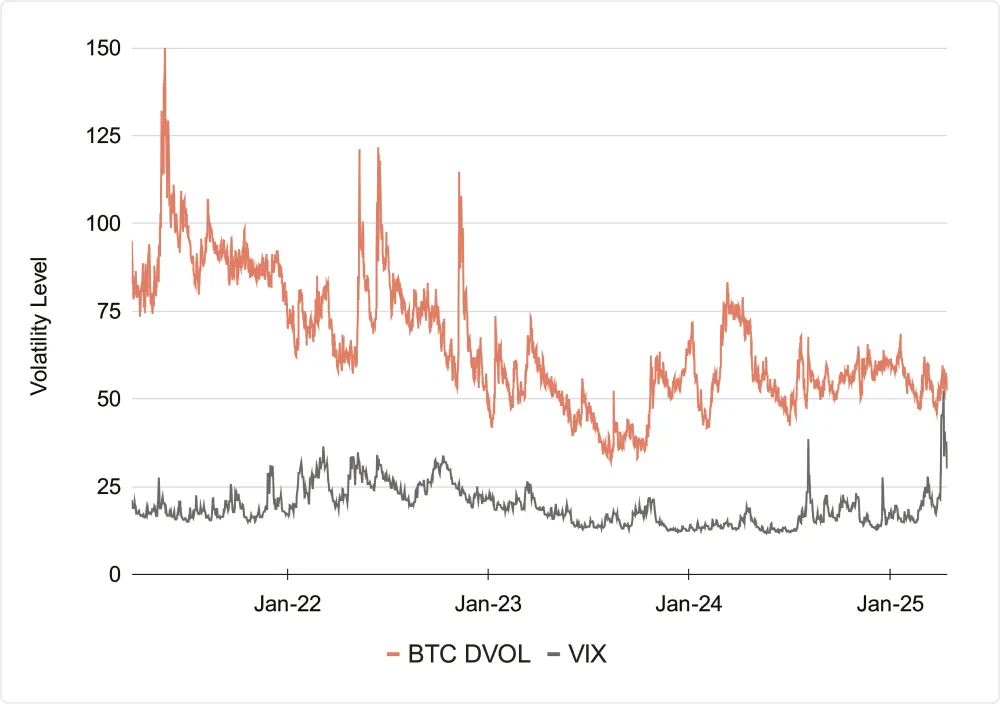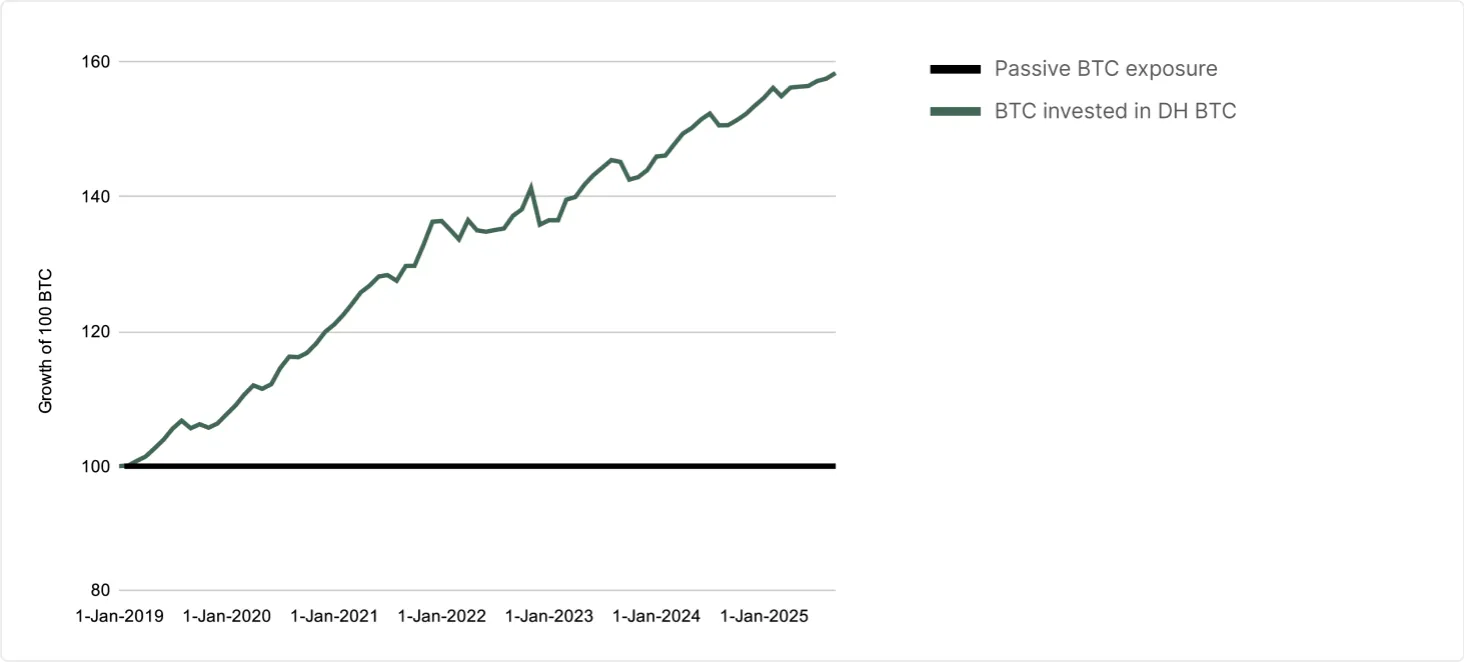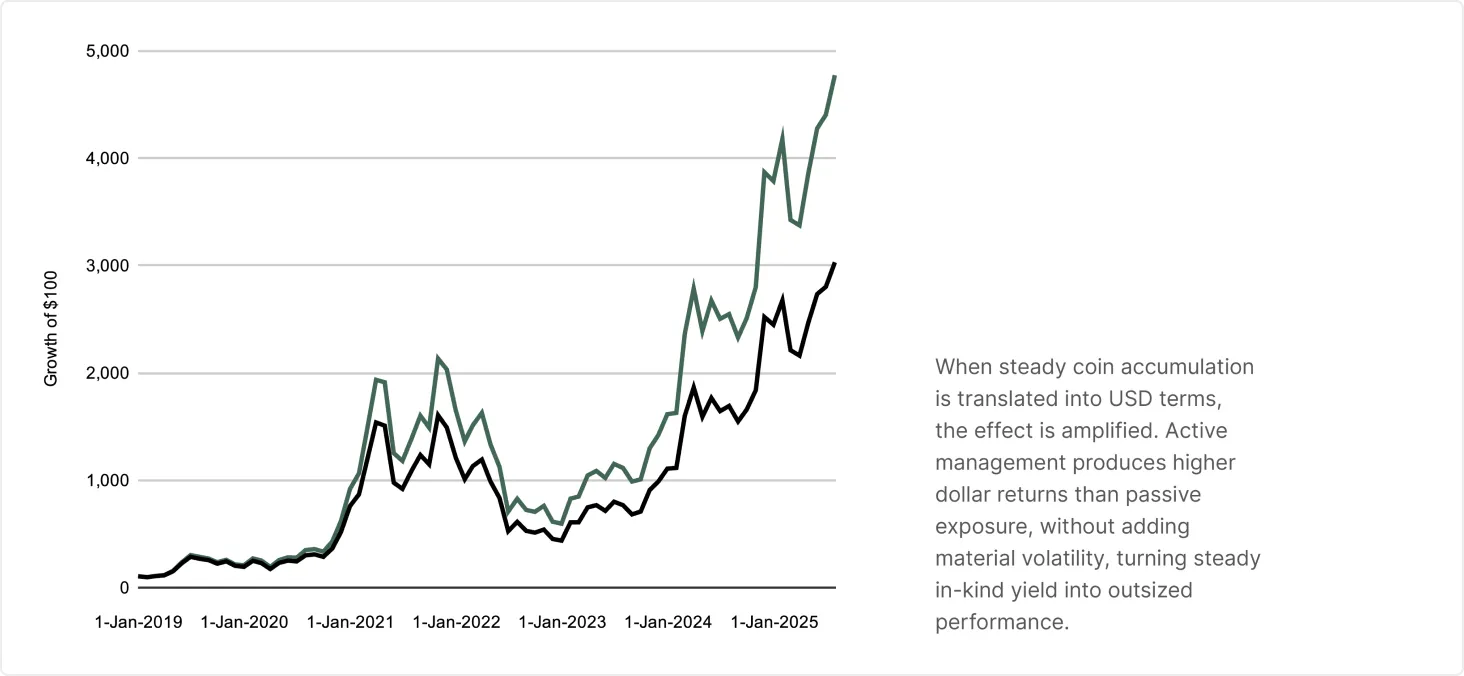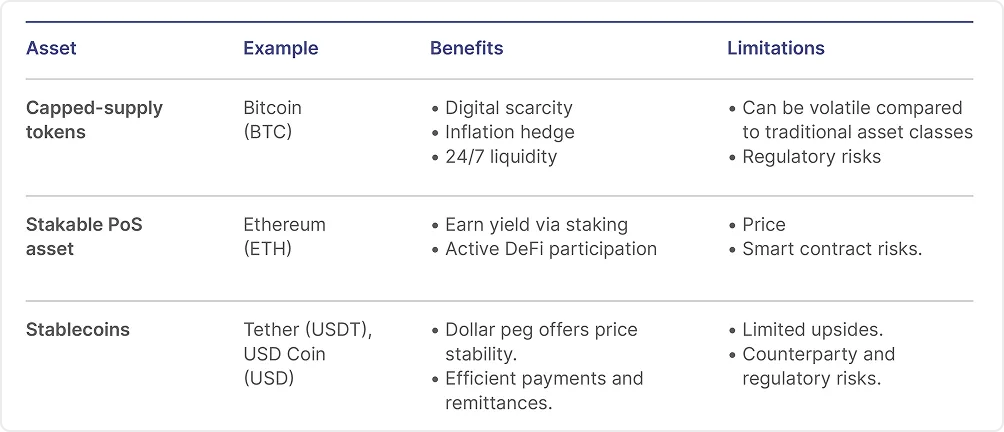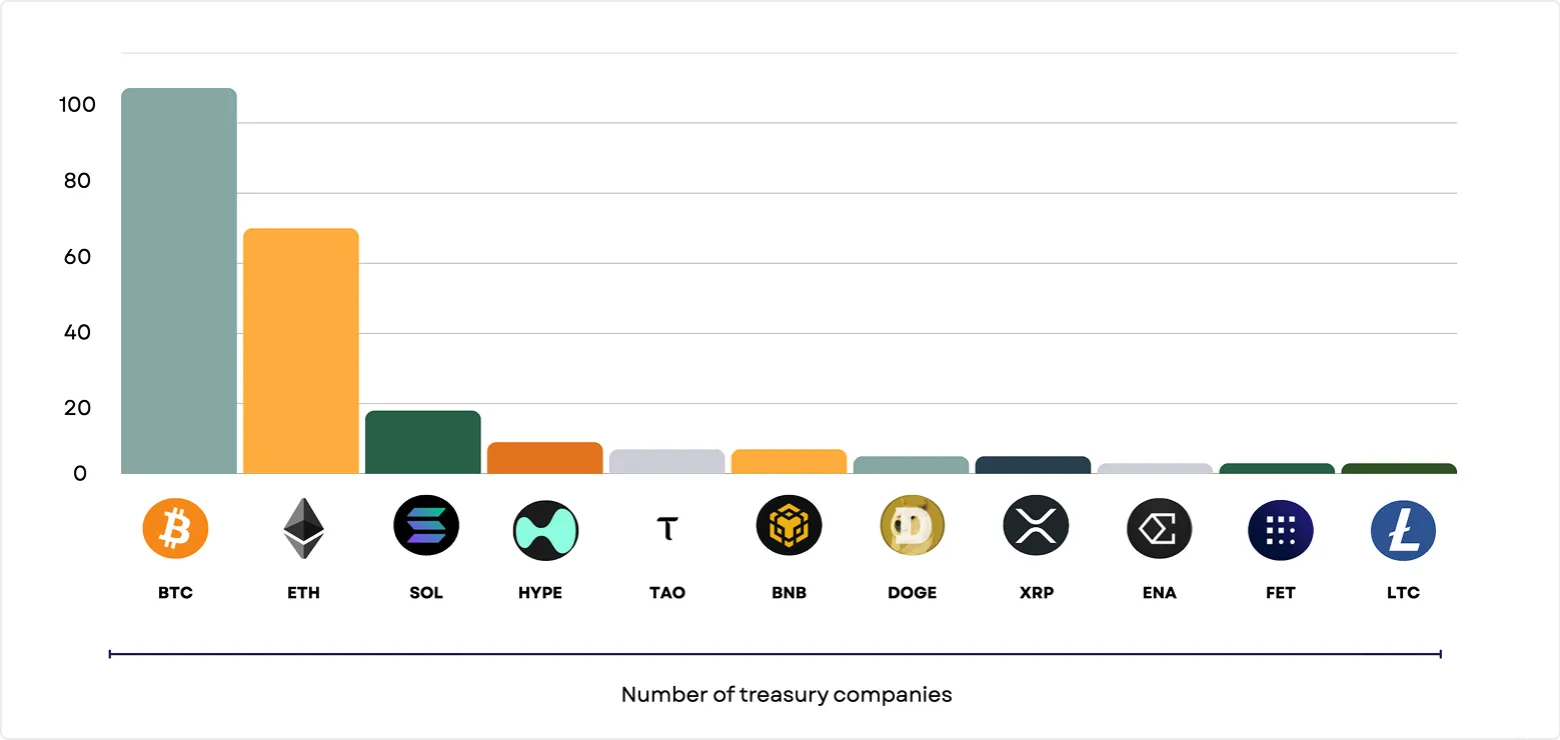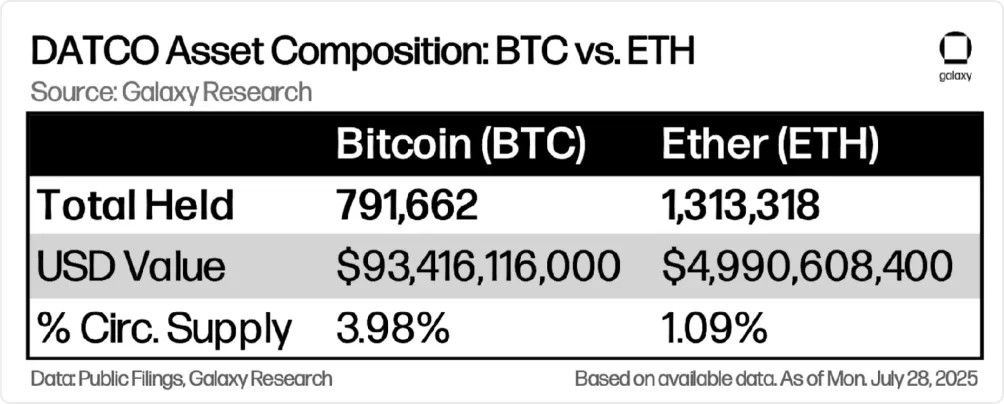

The rise of crypto treasury 2.0: Why corporate crypto balance sheets are evolving beyond holding | AI generated image by XBTO
The rise of crypto treasury 2.0: Why corporate crypto balance sheets are evolving beyond holding | AI generated image by XBTO

As of September 30, 2025, over one million BTC now sit on corporate balance sheets worldwide, led by MicroStrategy’s ~640,000 Bitcoins, roughly 3% of total supply. Ethereum treasuries are catching up fast, with public firms controlling over 4 million ETH, a growing share of the network (~3%).
Yet the model has clear limits. A pure buy-and-hold approach is entirely tethered to Bitcoin’s price cycle, exposing treasuries to volatility and offering little control over outcomes. More importantly, it’s no longer differentiating. Any company can hold Bitcoin, but few can manage it strategically. As capital markets mature, investors now reward firms that pair conviction with sophistication: disciplined risk management, income generation, and transparent reporting.
That shift marks the rise of Treasury 2.0: balance sheets that don’t just hold assets, but actively manage them. And increasingly, Ethereum, Solana, and stablecoins are entering the mix, not just as a hedge, but as a productive, programmable reserve that can earn yield and integrate with core business operations.
In this edition of The WIRE, we unpack Treasury 1.0’s legacy, why buy-and-hold is no longer enough, and the toolkit of Treasury 2.0.
To explore how digital assets are reshaping treasury design, from operational efficiency to the emergence of Digital Asset Treasury Companies (DATCOs), download our full white paper, “Treasury in the Age of Digital Assets”.
BTC Treasury 1.0 - The (Micro)Strategy model
The modern era of corporate crypto treasuries began in August 2020, when MicroStrategy (now rebranded as Strategy) announced it will convert a large portion of its reserves into Bitcoin. What started as a hedge against inflation quickly became the company’s defining strategy. Over the following years, Strategy raised billions through equity offerings and convertible debt to acquire Bitcoin, amassing more than ~640,000 BTC as of September 2025, roughly 3% of total supply.
Between 2020 and 2025, Strategy’s stock has surged more than 3,000%, at times trading at nearly 3x the net asset value of its Bitcoin holdings. Investors aren’t just buying Bitcoin exposure; they are paying for the company’s privileged access to capital markets, its ability to scale accumulation, and its role as a proxy for digital assets in equity portfolios.
The model works because it turns balance sheet management into capital markets strategy. By issuing new equity and convertible debt at a premium to book value, Strategy creates a self-reinforcing flywheel: rising share prices enabled new fundraising, which funds more Bitcoin purchases, increasing Bitcoin-per-share and further driving investor demand. This “wrapper premium” is transforming a software business into a publicly traded Bitcoin operating company, bridging the gap between institutional capital and digital assets.
For investors, this represents a new kind of corporate exposure, one where the balance sheet is the business. Management’s conviction, execution discipline, and financing skill become the differentiators, creating a form of management alpha that few could replicate.
The results were contagious, and other corporations followed, with many branding themselves around Bitcoin treasury strategies. By mid-2025, more than 180 public companies and 60 private firms worldwide reported Bitcoin holdings, together controlling over 1 million BTC.
But the model’s limits are becoming clearer. Bitcoin accumulation alone no longer differentiates one balance sheet from another. With more companies adopting the same playbook, capital markets are looking past conviction to execution quality, how firms finance, hedge, and actively manage their holdings. The message from investors is clear: it’s not what you hold, but how you manage it that creates value.
In short, Treasury 1.0 proved that digital assets could anchor a corporate balance sheet and attract capital. But it also revealed the fragility of a strategy built solely on accumulation.
Why buy-and-hold won't cut It: The demand for sophistication
As the crypto treasury phenomenon matures, stakeholders are demanding more than a passive "HODL" strategy. The market is shifting from rewarding companies simply for announcing crypto holdings to expecting active stewardship of those assets. Several factors are driving this change:
- Risk management: With Bitcoin's annualized volatility exceeding 50%, a pure buy-and-hold strategy exposes firms to significant balance sheet swings. The development of robust crypto derivatives markets now provides tools for hedging against downturns, and a modern crypto treasury is expected to have an active risk mitigation plan.
- Asset productivity: Large, idle crypto holdings represent an opportunity cost. Forward-looking firms are now finding ways to put these assets to work to generate additional returns through lending or staking. This marks a shift from a passive approach to one where treasurers actively seek yield from their holdings.
- Capital efficiency and liquidity: Unlike the static Bitcoin hoard of Treasury 1.0, the new model emphasizes liquidity planning. This includes using stablecoins and tokenized short-term debt as institutional-grade cash equivalents that can earn yield while remaining highly liquid.
- Governance and transparency: As treasury strategies become more complex, investors demand greater transparency. Firms are responding with formal treasury committees and more frequent, detailed disclosures on holdings and returns, building confidence that active strategies are being pursued responsibly.
The bottom line: markets no longer reward static exposure. To justify the risks of holding volatile assets, treasurers must demonstrate active stewardship: thoughtful acquisition planning, hedging downside, generating income, ensuring liquidity, and reporting with discipline. Buy-and-hold was Treasury 1.0. The next phase, Treasury 2.0, is about engineering balance sheets that can perform through cycles.
Treasury 2.0: A broader toolkit for a dynamic strategy
"Treasury 2.0" is about leveraging a richer set of financial tools, both traditional and crypto-native, to actively manage and enhance crypto balance sheets. It’s a move from a static allocation to a dynamic, engineered approach.
Key elements include:
1. Creative debt and equity financing
MicroStrategy set the template by raising billions through convertible bonds, preferred equity, and even Bitcoin-backed loans. This playbook is now broadening: corporates are tapping traditional debt markets, issuing equity hybrids, or even creating structured notes linked to BTC reserves. The goal isn’t just accumulation, it’s capital efficiency, using financing structures to scale exposure without overextending liquidity.
2. On-chain financing and tokenized debt
Treasury 2.0 is also about new issuance channels. Companies can raise capital directly on-chain through tokenized bonds and commercial paper. Siemens and Société Générale have already issued digital bonds, while OCBC Bank launched tokenized corporate debt under MAS regulation in Singapore. On the asset side, treasuries can park surplus cash into tokenized T-bills, yielding 4–5% annually with same-day liquidity. For treasurers, this is a breakthrough: cash equivalents that are programmable, globally accessible, and trade 24/7.
3. Structured yield and DeFi strategies
Passive reserves are being reimagined as income streams. Companies are beginning to implement options-based strategies - such as covered calls and put selling - to harvest Bitcoin’s structurally high volatility for yield. Others are staking Ethereum or Solana, running validator nodes, or deploying stablecoins into regulated money market funds. Done responsibly, these activities turn treasuries into profit centers rather than cost centers.
4. Diversification across assets
Diversification in corporate treasuries is evolving from a risk-management exercise into a balance-sheet design strategy. The leading firms are no longer defined by what they hold, but by how each asset type serves a distinct financial purpose.
Bitcoin remains the cornerstone: a capped-supply, non-sovereign asset prized for its digital scarcity, liquidity, and inflation-hedge characteristics. It anchors credibility with investors and provides a durable hedge against monetary uncertainty, the digital equivalent of gold on the balance sheet.
Ethereum introduces productivity. As a proof-of-stake asset , it allows treasuries to earn native yield (3-5%) through staking while maintaining exposure to one of the world’s most widely used financial settlement networks. ETH’s programmability also unlocks participation in tokenized debt, stablecoin liquidity, and DeFi-based financing, turning reserves into active, income-generating capital.
Solana treasuries are also on the rise, reflecting demand for high-throughput networks and ecosystem participation.
Stablecoins complete the structure by providing price stability and operational liquidity. Pegged to fiat currencies, they serve as 24/7 settlement tools for payments, remittances, and short-term liquidity management. When allocated into tokenized T-bills or regulated money-market wrappers, they can even generate modest yields without sacrificing convertibility.
The evolution is clear: Treasury 2.0 is the fusion of traditional corporate finance and digital-native tools - issuing debt, managing liquidity, hedging exposures, and generating income - but now executed on-chain and in real time.
The next wave: ETH Treasuries and programmable balance sheets
The next frontier in corporate treasury management is not about replacing Bitcoin, but about broadening the balance sheet. If BTC has proven its value as a scarce, non-sovereign reserve asset, Ethereum is showing how treasuries can go further, turning reserves into productive, programmable capital.
Ethereum’s proof-of-stake system allows corporates to earn 3-5% annual staking rewards, effectively creating a built-in yield on holdings. This dual profile, growth potential plus recurring income, makes ETH behave more like a dividend-paying growth stock than a static reserve.
That’s why public firms now hold more than 4 million ETH, with leaders like BitMine Immersion (~1.7M ETH) and SharpLink Gaming (~797k ETH) integrating staking and validator operations into their treasury strategies. Transparency is also higher: firms like SharpLink publish weekly disclosures on their ETH activity, setting a new bar for governance.
What sets ETH apart is programmability. Treasuries can embed assets into smart contracts to automate liquidity, collateralize ETH to raise capital, or issue tokenized debt directly on-chain. In some cases, reserves even become part of the business model: Allied Gaming, for instance, framed its BTC and ETH treasury as the foundation for tokenizing tickets, IP rights, and revenue streams.
In this sense, corporate treasuries are evolving into multi-asset systems:
- Bitcoin for scarcity and macro resilience.
- Ethereum for yield and programmability.
- Stablecoins and tokenized debt for liquidity and capital efficiency.
The result is not Treasury 1.0 versus 2.0, but a plural balance sheet, where different assets play distinct roles in creating resilience, optionality, and long-term value.
Treasuries as competitive advantage
Corporate treasuries are no longer judged by how much they hold, but by how effectively they manage what’s inside. The market premium once attached to bold Bitcoin bets is shifting toward firms that can show discipline, raising capital without overextending, hedging volatility, generating yield, and disclosing with real transparency.
The strongest balance sheets will be plural, not single-asset stories. Bitcoin will remain the anchor of resilience, but Ethereum’s yield and programmability are already redefining how reserves can work, while stablecoins and tokenized debt are emerging as the next generation of cash equivalents. The point is not to pick a winner, but to design treasuries where each instrument plays its role.
What sets the new leaders apart is optionality. In a world of shifting rates, volatile currencies, and geopolitical risk, the ability to move seamlessly between fiat, stablecoins, and digital assets is becoming a competitive edge. Balance sheets that “do” - not just “store” - are the ones that will define Treasury 2.0.
The full breakdown
In our first article, "Navigating Crypto Volatility: The Advantages of Active Management," we explored how the high volatility and low correlation of digital assets with traditional asset classes create unique opportunities for active managers. We discussed how these characteristics enable active managers to execute tactical trading strategies, capitalizing on short-term price movements and market inefficiencies. Building on that foundation, we now turn our attention to the unique market microstructure of digital assets.
Conducive market microstructure of digital assets
The market microstructure of digital assets - a framework that defines how crypto trades are conducted, including order execution, price formation, and market interactions - sets the stage for active management to thrive. This unique ecosystem, characterized by its continuous trading hours, diverse trading venues, and substantial market liquidity, offers several advantages for active management, providing a fertile ground for sophisticated investment strategies.
24/7/365 market access
One of the defining characteristics of digital asset markets is their continuous, round-the-clock operation.
Unlike traditional financial markets that operate within specific hours, cryptocurrency markets are open 24 hours a day, seven days a week, all year round. This continuous trading capability is particularly advantageous for active managers for several reasons:
- Immediate response to market events: Unlike traditional markets that close after regular trading hours, digital asset markets allow managers to react immediately to breaking news or events that could impact asset prices. For instance, if a significant economic policy change occurs over the weekend, managers can adjust their positions in real-time without waiting for markets to open.
- Managing volatility: Continuous trading provides more opportunities to capitalize on price movements and volatility. Active managers can take advantage of this by implementing strategies such as short-term trading or hedging to mitigate risks and lock in gains whenever market conditions change. For instance, if there’s a sudden drop in the price of Bitcoin, managers can quickly sell their holdings to minimize losses or buy in to capitalize on the lower prices.
Variety of trading venues
The proliferation and variety of trading venues is another crucial element of the digital asset market structure. The extensive landscape of over 200 centralized exchanges (CEX) and more than 500 decentralized exchanges (DEX) offers a wide array of platforms for cryptocurrency trading. This diversity is beneficial for active managers in several ways:
- Risk management and diversification: By spreading trades across various exchanges, active managers can mitigate counterparty risk associated with any single platform. Additionally, the ability to trade on both CEX and DEX platforms allows managers to diversify their strategies, incorporating different levels of decentralization, regulatory environments, and security features.
- Arbitrage opportunities: Different venues often exhibit price discrepancies, presenting arbitrage opportunities. For example, managers can buy an asset on one exchange at a lower price and sell it on another where the price is higher, thus generating risk-free profits.
- Access to diverse liquidity pools: Multiple trading venues provide access to diverse liquidity pools, ensuring that managers can execute large trades without significantly impacting the market price.
Spot and derivatives markets (Variety of instruments)
The seamless integration of spot and derivatives markets within the digital asset space presents a considerable advantage for active managers. With substantial liquidity in both markets, they can implement sophisticated trading strategies and manage risk more effectively.
For instance, as of August 8 2024, Bitcoin (BTC) boasts a daily spot trading volume of $40.44 billion and an open interest in futures of $27.75 billion. Additionally, derivatives such as futures, options, and perpetual contracts enable managers to hedge positions, leverage trades, and employ complex strategies that can amplify returns.

Overall, the benefits for active managers include:
- Hedging and risk management: Derivatives offer a powerful tool for hedging against unfavorable price movements, enabling more efficient risk management. For instance, a manager holding a substantial amount of Bitcoin in the spot market can use Bitcoin futures contracts to safeguard against potential price drops, thereby enhancing risk control.
- Access to leverage: Managers can use derivatives to leverage their positions, amplifying potential returns while maintaining control over risk exposure. For instance, by employing options, a manager can gain exposure to an underlying asset with only a fraction of the capital needed for a direct spot purchase, thereby enabling more capital-efficient investment strategies.
- Strategic flexibility: By integrating spot and derivatives markets, managers can implement sophisticated strategies designed to capitalize on diverse market conditions. For instance, they may engage in volatility selling, where options are sold to generate income from market volatility, regardless of price direction. Additionally, managers can leverage favorable funding rates in perpetual futures markets to enhance yield generation. Basis trading, another strategy, involves taking offsetting positions in spot and futures markets to profit from price differentials, enabling returns that are independent of market movements.
Exploiting market inefficiencies
Digital asset markets, being relatively nascent, are less efficient compared to traditional financial markets. These inefficiencies arise from various factors, including regulatory differences, market segmentation, and varying levels of market maturity. For example:
- Pricing anomalies: Phenomena like the "Kimchi premium," where cryptocurrency prices in South Korea trade at a premium compared to other markets, create arbitrage opportunities. Managers can exploit these by buying assets in one market and selling them in another at a higher price.
- Exploiting mispricings: Active managers can identify and capitalize on mispricings caused by market inefficiencies, using strategies such as statistical arbitrage and mean reversion.
The unique aspects of the digital asset market structure create an exceptionally conducive environment for active management. Continuous trading hours and diverse venues provide the flexibility to react quickly to market changes, ensuring timely execution of trades. The availability of both spot and derivatives markets supports a wide range of sophisticated trading strategies, from hedging to leveraging positions. Market inefficiencies and pricing anomalies offer numerous opportunities for generating alpha, making active management particularly effective in the digital asset space. Furthermore, the ability to hedge and manage risk through derivatives, along with exploiting uncorrelated performance, enhances portfolio resilience and stability.
In our next article, we'll delve into the various techniques active managers employ in the digital asset markets, showcasing real-world use cases.
Read full disclaimer

